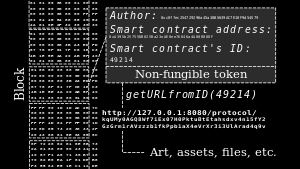
Back Nieverwisselbare item AF رموز غير قابلة للاستبدال Arabic NFT AZ Незаменим токен Bulgarian অবিনিময়যোগ্য নিদর্শন Bengali/Bangla Nezamjenjivi token BS Criptovalor no fungible Catalan NFT Czech Non-fungible token Danish Non-Fungible Token German

A non-fungible token (NFT) is a unique digital identifier that is recorded on a blockchain and is used to certify ownership and authenticity. It cannot be copied, substituted, or subdivided.[1] The ownership of an NFT is recorded in the blockchain and can be transferred by the owner, allowing NFTs to be sold and traded. Initially pitched as a new class of investment asset, by September 2023, one report claimed that over 95% of NFT collections had zero monetary value.[2][3]
NFTs can be created by anybody and require few or no coding skills to create. NFTs typically contain references to digital files such as artworks, photos, videos, and audio. Because NFTs are uniquely identifiable, they differ from cryptocurrencies, which are fungible (hence the name non-fungible token).
Proponents claim that NFTs provide a public certificate of authenticity or proof of ownership, but the legal rights conveyed by an NFT can be uncertain. The ownership of an NFT as defined by the blockchain has no inherent legal meaning and does not necessarily grant copyright, intellectual property rights, or other legal rights over its associated digital file. An NFT does not restrict the sharing or copying of its associated digital file and does not prevent the creation of NFTs that reference identical files.
NFT trading increased from US$82 million in 2020 to US$17 billion in 2021.[4] NFTs have been used as speculative investments and have drawn criticism for the energy cost and carbon footprint associated with some types of blockchain, as well as their use in art scams.[5] The NFT market has also been compared to an economic bubble or a Ponzi scheme.[6] At their peak, the three biggest NFT platforms were Ethereum, Solana, and Cardano.[7] In 2022, the NFT market collapsed; a May 2022 estimate was that the number of sales was down over 90% compared to 2021.[8]
- ^ "Definition of NFT". Merriam-Webster. July 20, 2023.
- ^ Yang, Maya (September 22, 2023). "The vast majority of NFTs are now worthless, new report shows". The Guardian. Retrieved September 26, 2023.
- ^ Vigliarolo, Brandon (September 21, 2023). "95% of NFTs now totally worthless, say researchers". theregister.com. Retrieved September 26, 2023.
- ^ "NFTs Hit $17B In Trading in 2021, Up 21,000%". pymnts.com. March 10, 2022. Retrieved May 5, 2022.
- ^ Genç, Ekin (October 5, 2021). "Investors Spent Millions on 'Evolved Apes' NFTs. Then They Got Scammed". Vice Media. Retrieved November 9, 2021.
- ^ Hawkins, John (January 13, 2022). "NFTs, an overblown speculative bubble inflated by pop culture and crypto mania". The Conversation. Retrieved May 7, 2022.
- ^ Linares, Maria Gracia Santillana. "Cardano NFTs Becomes Third-Largest NFT Protocol By Trading Volume". Forbes. Retrieved April 25, 2023.
- ^ Cite error: The named reference
flatliningwas invoked but never defined (see the help page).